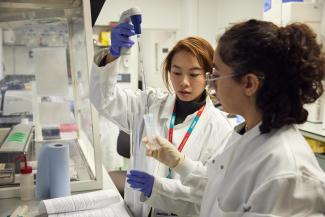Research funded by us has revealed how important a particular gene is for controlling how fat is stored in the body, and its links with the development of type 2 diabetes. This could open up new approaches to treat the condition and tackle blood sugar levels in more effective ways.

Our research fellow Dr George Mcilroy and his team at the University of Aberdeen have published new findings showing the potential of a gene therapy to treat type 2 diabetes. They’ve been studying a very rare genetic condition called congenital generalised lipodystrophy, where people are born without a gene that instructs their bodies to store fat. This causes fat to build up inside important organs, like the liver, instead of being stored safely under the skin. In turn, this can lead to insulin resistance and type 2 diabetes.
Dr Mcilroy has studied mice with lipodystrophy to explore what happens if they’re given back the gene they’re missing. This could help us learn more about the links between body fat and the development of type 2 diabetes.
Gene therapies
Scientists have been researching gene therapy for more than 40 years. It holds promise for treating a wide range of conditions, including cancer, cystic fibrosis, heart disease and diabetes. This pioneering approach acts on the most basic level of the human body – our genes. Proteins are the brick-and-mortar, that make up our cells and tissues. And genes contain the instructions for making those proteins.
Gene therapy involves replacing a faulty gene or adding in a new one. This is done by delivering a gene into the body using a delivery vehicle, called a vector. Harmless viruses can be used as vectors because they have evolved to be very good at getting into cells.
Dr Mcilroy and his team investigated whether a virus could deliver a missing gene to mice with congenital generalised lipodystrophy and restore their ability to store fat and respond to insulin.
Controlling weight gain
The researchers gave one group of mice the gene therapy and compared them to another group that didn’t receive the treatment. They found that mice who didn’t receive the gene therapy increased their weight by 25-30%, while those who did receive the therapy gained much less weight. This is likely due to the gene therapy's ability to reverse the mice's enlarged livers, but further research is needed to confirm this.
Normalising blood sugar levels
They also found that treatment with gene therapy helped the mice to make more insulin when they were given sugar and use that insulin more effectively, which lowered their blood sugar levels.
The findings show that gene therapy corrects problems with body fat storage in mice and holds the potential to treat type 2 diabetes. As a next step, with our funding, Dr Mcilroy will aim to discover how gene therapy affects blood sugar levels, by looking at changes that the therapy brings about in the liver, which is a key organ involved in blood sugar control. He’ll do this by studying the gene activity in single liver cells, using cutting-edge technology.
This is important, but very early-stage research in mice. With continued research, the discoveries could pave the way for new treatments for people living with type 2 diabetes that tackle blood sugar levels in new, more effective ways.
